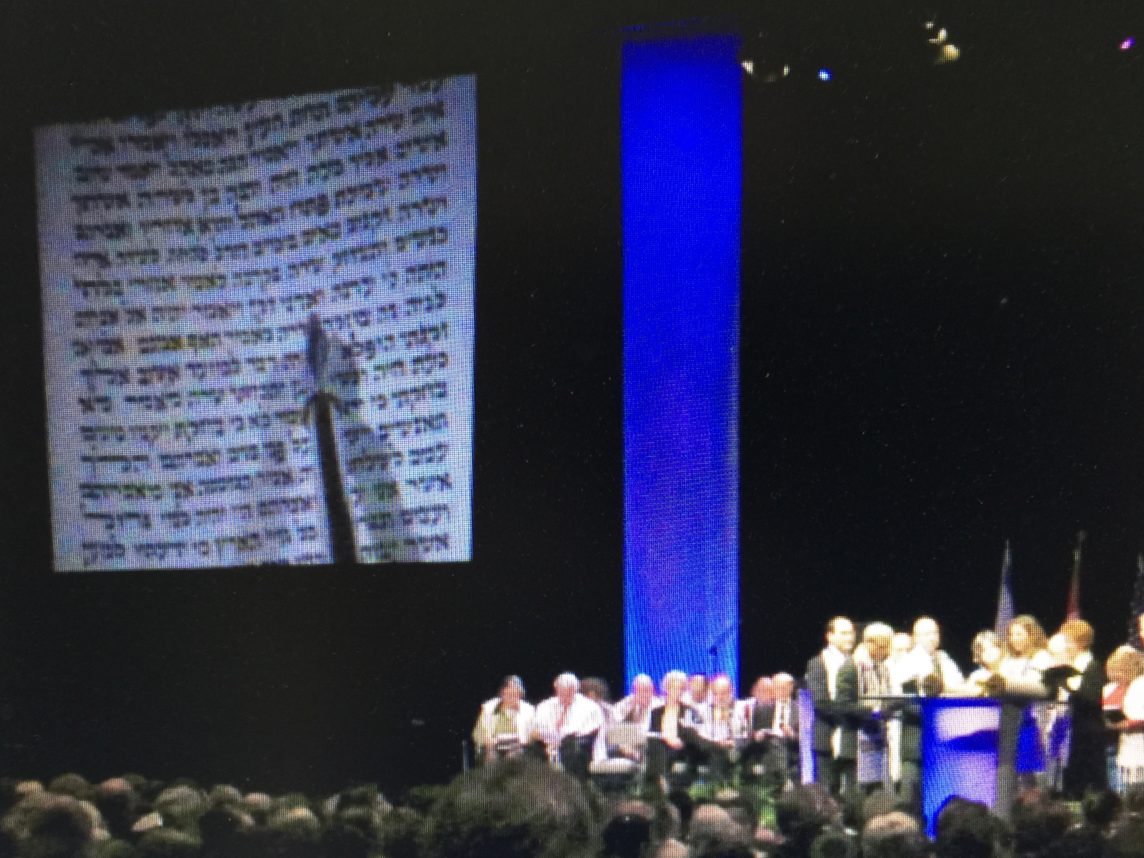
Several years ago I attended a session at the Biennial Conference of the Reform movement (the Union for Reform Judaism) on the visual benefits of projecting the prayer book and the weekly Torah portion onto large screens in place of prayer books. It was at the time a new way to draw a congregation together while freeing the pews of books and papers. Though I understood the benefit of having the text available in plain sight to everyone present, especially in a large congregation, and the ability to add new songs and poetry that are not contained already in prayer books, I was uncomfortable with it and preferred then and still prefer to have an actual prayer book in my hands.
Having said this, at my congregation we use large screens for prayer twice a year, on the mornings of Rosh Hashanah and Yom Kippur at our family services with pre-school age through first grade children, their parents and grandparents. All the 700 in attendance need to do do is look forward towards the bimah and there they can read/sing the blessings and view colorful illustrations and photographs. For this particular population, projected prayer works well.
It’s one thing, however, to use projected prayer and illustrations/photographs for small children and their parents, and it’s quite another to use it in place of prayer books at Shabbat services for elementary school-age students, teens, and adults.
In recent days on the private Reform Rabbi List-Serve called RAVKAV where rabbis talk to each other about anything and everything of current concern, there has been a thoughtful discussion about the benefits and deficits of projected prayer in place of using actual siddurim. I found the discussion provocative and engaging, and so I shared some of the posts (I removed the writers’ names to maintain confidentiality) with my fellow clergy in my congregation. I received the following statement from our cantorial soloist and music director, Shelly Fox. Shelly is a 2nd year cantorial student at the Academy for Jewish Religion (AJR) here in Los Angeles. She is a world class singer and a thoughtful, evocative and sensitive Jew and prayer leader. I share her words with her permission:
“It’s one thing to project the words to prayers and enable people to follow along and lift their faces out of a book and sing together, but once we start talking about projecting imagery and then taking it further and using a large screen LED TV for clear, bright images, now we’re getting into the territory of another screen to watch.
I think that when people see a TV screen they shut off their brains. They get lulled into watching, not doing. I also think that prayer is both communal and personal and to give everyone imagery to watch takes them out of their own heads. It’s my same argument to musical settings of prayers in what I call “interpretive English.” I am not opposed to singing prayers in English but it bothers me when a prayer isn’t a direct translation [i.e. from the Hebrew, Ladino, or Yiddish] but is the songwriter’s impression of the prayer. I want the freedom to interpret a prayer how I feel it, which can change on any given day or at different times in my life. Giving someone a specific image to look at while praying cuts them off from their own inner dialog. …I think this is part of a larger trend of the dumbing down of our society. The less people think for themselves, the less they engage in critical thinking. We will have a nation of people plugged into (lulled by) screens and that leaves them vulnerable to whoever wants to control them, be it for good or for ill.”
I agree with Shelly. After all, we Jews are Am haSefer – The People of the Book. I always prefer holding a book in my hands. I don’t read books on Kindle and though it’s more convenient to download books especially when traveling instead of carrying them in my luggage, I prefer the latter to the former.
A colleague wrote to me after I posted Shelly’s response on RAVKAV. He agreed with her saying: “We are a book culture — which means that we should be able to browse through a book and study it. The last thing we need is to strengthen our addiction to screens.”






















 More news and opinions than at a Shabbat dinner, right in your inbox.
More news and opinions than at a Shabbat dinner, right in your inbox.